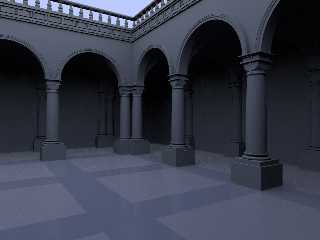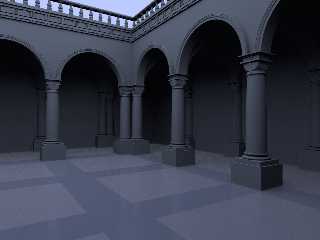 |
 |
|
 |
|
 |
|  |
|  |
|
 |
|
 |
|  |
|  |
|
 |
Toying around with an AO-only-patch for the radiosity code.
Render time for the classic recursion_limit 1 radiosity image (#1): 3
min 12 seconds.
Render time for the AO-only image (#2): 2 min 27 seconds.
The scene is an ideal case for this approach: The sky sphere functions
as the only light source, with a quite uniform pigment, and the relative
distance of objects is comparatively uniform. In such an environment,
single-recursion radiosity can be replaced by an AO-based approach
(shooting rays only to determine distance of objects, rather than color)
with virtually no change in visual appearance.
In this text scene, the texturing is still rather simple. To add /any/
challenge at all, I applied some 10-layer micronormals-based blurred
reflection to the floor. More complex scenes may show a more pronounced
speed advantage of the AO-based approach.
While this approach may not work equally well in other environments, I
guess the idea is worth being pursued further.
Post a reply to this message
Attachments:
Download 'patio-radio_radiosity.png' (266 KB)
Download 'patio-radio_ao.png' (254 KB)
Preview of image 'patio-radio_radiosity.png'

Preview of image 'patio-radio_ao.png'

|
 |
|  |
|  |
|
 |
|
 |
|  |
|  |
|
 |
On 04/06/2011 03:01 PM, clipka wrote:
> Toying around with an AO-only-patch for the radiosity code.
>
> Render time for the classic recursion_limit 1 radiosity image (#1): 3
> min 12 seconds.
>
> Render time for the AO-only image (#2): 2 min 27 seconds.
>
> The scene is an ideal case for this approach: The sky sphere functions
> as the only light source, with a quite uniform pigment, and the relative
> distance of objects is comparatively uniform. In such an environment,
> single-recursion radiosity can be replaced by an AO-based approach
> (shooting rays only to determine distance of objects, rather than color)
> with virtually no change in visual appearance.
>
> In this text scene, the texturing is still rather simple. To add /any/
> challenge at all, I applied some 10-layer micronormals-based blurred
> reflection to the floor. More complex scenes may show a more pronounced
> speed advantage of the AO-based approach.
>
> While this approach may not work equally well in other environments, I
> guess the idea is worth being pursued further.
The AO shadows look much smoother ... but what I was really interested
in what what you said about the floor. A layer texture? ... or some
other voodoo! ;-)
Post a reply to this message
|
 |
|  |
|  |
|
 |
|
 |
|  |
|  |
|
 |
clipka <ano### [at] anonymous org> wrote:
> While this approach may not work equally well in other environments, I
> guess the idea is worth being pursued further.
Excellent!
While you're hacking away at this please ponder some ways of using the occlusion
for masking of specific texturing, to maybe use for non-reflective areas or
occlusion textures instead of just darkening (similar to the grime macro
Trevor's been working on).
-------------------------------------------------
www.McGregorFineArt.com org> wrote:
> While this approach may not work equally well in other environments, I
> guess the idea is worth being pursued further.
Excellent!
While you're hacking away at this please ponder some ways of using the occlusion
for masking of specific texturing, to maybe use for non-reflective areas or
occlusion textures instead of just darkening (similar to the grime macro
Trevor's been working on).
-------------------------------------------------
www.McGregorFineArt.com
Post a reply to this message
|
 |
|  |
|  |
|
 |
|
 |
|  |
|  |
|
 |
clipka <ano### [at] anonymous org> wrote:
> While this approach may not work equally well in other environments, I
> guess the idea is worth being pursued further.
Was this inspired by recent events, or simply from an idea approaching out of
the blue?
Could the AO be applied to some sort of edge-finding scheme, where both inside
and outside edges are found and turned into a usable pigment? Not that I'm
holding my breath; even a speed increase for environmental lighting would be
welcome :)
Sam org> wrote:
> While this approach may not work equally well in other environments, I
> guess the idea is worth being pursued further.
Was this inspired by recent events, or simply from an idea approaching out of
the blue?
Could the AO be applied to some sort of edge-finding scheme, where both inside
and outside edges are found and turned into a usable pigment? Not that I'm
holding my breath; even a speed increase for environmental lighting would be
welcome :)
Sam
Post a reply to this message
|
 |
|  |
|  |
|
 |
|
 |
|  |
|  |
|
 |
Sorry for the late reply, I'm a "bit" behind in this newsgroup...
Am 06.04.2011 20:47, schrieb Jim Holsenback:
>> In this text scene, the texturing is still rather simple. To add /any/
>> challenge at all, I applied some 10-layer micronormals-based blurred
>> reflection to the floor. More complex scenes may show a more pronounced
>> speed advantage of the AO-based approach.
>>
>> While this approach may not work equally well in other environments, I
>> guess the idea is worth being pursued further.
>
> The AO shadows look much smoother ... but what I was really interested
> in what what you said about the floor. A layer texture? ... or some
> other voodoo! ;-)
Not actually a layered texture, but an average texture:
#declare Tx = texture {
pigment {color rgb <0.776,0.706,0.706>}
finish {ambient 0.2 diffuse 0.6 reflection { 0.0 1.0 fresnel }
conserve_energy }
normal { bumps 0.5 scale 0.0001 }
}
plane {y,0
texture { average
texture_map {
[1 Tx translate y*0.00]
[1 Tx translate y*0.01]
[1 Tx translate y*0.02]
[1 Tx translate y*0.03]
[1 Tx translate y*0.04]
[1 Tx translate y*0.05]
[1 Tx translate y*0.06]
[1 Tx translate y*0.07]
[1 Tx translate y*0.08]
[1 Tx translate y*0.09]
}
}
interior { ior 1.5 }
}
The classic micronormals approach that doesn't need anti-aliasing or
focal blur to work. Voodoo, but nothing new.
Post a reply to this message
|
 |
|  |
|  |
|
 |
|
 |
|  |
|  |
|
 |
Am 07.04.2011 04:50, schrieb Samuel Benge:
> clipka<ano### [at] anonymous org> wrote:
>> While this approach may not work equally well in other environments, I
>> guess the idea is worth being pursued further.
>
> Was this inspired by recent events, or simply from an idea approaching out of
> the blue?
Sitting in the back of my head for ages, but brought to the front by
recent events.
> Could the AO be applied to some sort of edge-finding scheme, where both inside
> and outside edges are found and turned into a usable pigment? Not that I'm
> holding my breath; even a speed increase for environmental lighting would be
> welcome :)
As a matter of fact that's how my earlier approach at a proximity
pattern worked - or rather, failed to work, as I experienced some
drawbacks back then. But maybe a few things I ironed out now for the AO
implementation might get me around those. org> wrote:
>> While this approach may not work equally well in other environments, I
>> guess the idea is worth being pursued further.
>
> Was this inspired by recent events, or simply from an idea approaching out of
> the blue?
Sitting in the back of my head for ages, but brought to the front by
recent events.
> Could the AO be applied to some sort of edge-finding scheme, where both inside
> and outside edges are found and turned into a usable pigment? Not that I'm
> holding my breath; even a speed increase for environmental lighting would be
> welcome :)
As a matter of fact that's how my earlier approach at a proximity
pattern worked - or rather, failed to work, as I experienced some
drawbacks back then. But maybe a few things I ironed out now for the AO
implementation might get me around those.
Post a reply to this message
|
 |
|  |
|  |
|
 |
|
 |
|  |




![]()